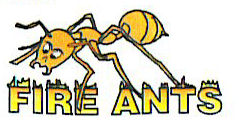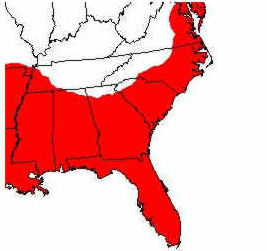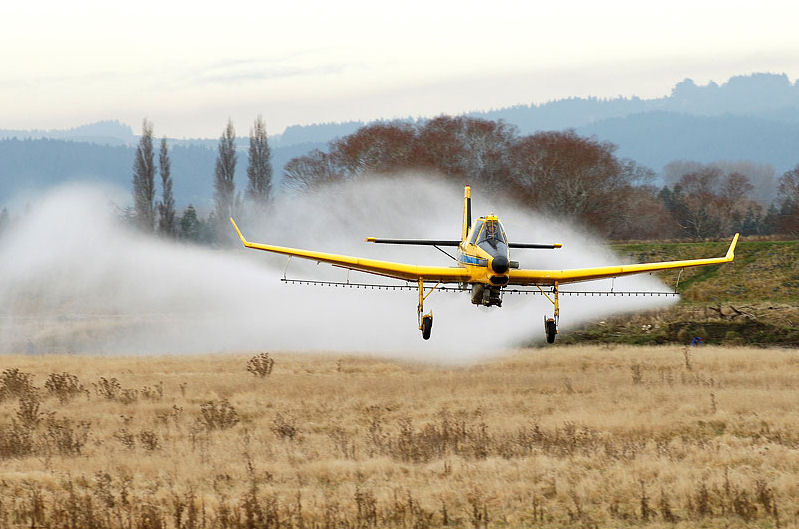
After World War II, the spread of these fire ants was
largely due to the sale of grass sod and woody ornamental plants used in
landscaping. Fire ants include a
large group of reddish-brown to black ants that normally spread by one of the
following methods: seasonal relocations, migration in nursery stock, natural
flights, and after floods rafting on water. Ants can be blown by the wind
12 miles during mating flights. They can “hitchhike” on birds or mass
together to form a floating ball to ride out a flood. Fire ant workers
 are
sterile females that range in size from .08” to .2” in length. The larger
workers are called majors, the medium sized are called medias and the smallest
size are called minors. All of the workers sting and inject a venom that
causes blisters and allergic responses, including possible anaphylactic shock. A
single fire ant can grab hold with its mandibles and then whip its abdomen down
and sting multiple times, injecting the poison each time. They are now
found in 11 southeastern states and over 25,000 people a year seek medical
attention from fire ant stings. A fire ant mound can be 15" - 24" in
diameter and 10" - 18" high and 1' - 3' deep with some tunnels extending 5' or
more down to the water table and can contain 80,000 to over 250,000 workers.
A.K.A. the six-legged scourge of the South.
Note: They are adapting to the cold and coming North.
are
sterile females that range in size from .08” to .2” in length. The larger
workers are called majors, the medium sized are called medias and the smallest
size are called minors. All of the workers sting and inject a venom that
causes blisters and allergic responses, including possible anaphylactic shock. A
single fire ant can grab hold with its mandibles and then whip its abdomen down
and sting multiple times, injecting the poison each time. They are now
found in 11 southeastern states and over 25,000 people a year seek medical
attention from fire ant stings. A fire ant mound can be 15" - 24" in
diameter and 10" - 18" high and 1' - 3' deep with some tunnels extending 5' or
more down to the water table and can contain 80,000 to over 250,000 workers.
A.K.A. the six-legged scourge of the South.
Note: They are adapting to the cold and coming North.
Fire ants are omnivores
and will eat plant and animal material including mice, turtles, snakes, and
other vertebrates, crops, plants, saplings, wildflowers, fruit, and grass but
prefer insects. U. S. fire ants readily defend their mound.
Disturbed or injured workers release alarm pheromones. There are four
major species, two native and two imported, found in the U. S. from the
Carolinas to California. Mating between the winged forms or alates takes place 300' to 800' in the air, usually in late spring or early
summer. The males fly up first and wait for the females, after mating, the
males die and the newly mated queens seek moist areas, normally within one mile
of the
 mother colony. If the female lands on a suitable moist site, she removes
her wings and digs a small burrow in the soil and then seals it. Within 24
hours the queen begins laying eggs, normally only 10 - 15 in the first cluster.
The queen ant can live up to 7 years and will produce up to 1,500 to 1,600 eggs
per day throughout her life. Queens are the first to be fed proteins, so any
fire ant bait has to be protein-based. Fire ants feed on honeydew, sugars,
proteins, oils, seeds, plants and insects. Fire ants frequently enter and nest
in houses and are attracted to water and electrical wires and their associated
magnetic fields or impulses. They can ruin gas pumps, transformers, traffic
lights, air conditioners, heat pumps and other electrical equipment. Locate ant
activity inside by watching the ant trail and follow back to the void and treat
with ant baits or dusts. They will kill plants by
feeding on seeds or by girdling freshly planted nursery stock. Fire ant workers
compensate for changing conditions, e.g., temperature and humidity by moving the
larvae and queen to suitable locations within the mound. On cool mornings in
the summer the queens are near the top of the mounds where it is warmer; as the
day heats up the queens go deeper into the soil.
mother colony. If the female lands on a suitable moist site, she removes
her wings and digs a small burrow in the soil and then seals it. Within 24
hours the queen begins laying eggs, normally only 10 - 15 in the first cluster.
The queen ant can live up to 7 years and will produce up to 1,500 to 1,600 eggs
per day throughout her life. Queens are the first to be fed proteins, so any
fire ant bait has to be protein-based. Fire ants feed on honeydew, sugars,
proteins, oils, seeds, plants and insects. Fire ants frequently enter and nest
in houses and are attracted to water and electrical wires and their associated
magnetic fields or impulses. They can ruin gas pumps, transformers, traffic
lights, air conditioners, heat pumps and other electrical equipment. Locate ant
activity inside by watching the ant trail and follow back to the void and treat
with ant baits or dusts. They will kill plants by
feeding on seeds or by girdling freshly planted nursery stock. Fire ant workers
compensate for changing conditions, e.g., temperature and humidity by moving the
larvae and queen to suitable locations within the mound. On cool mornings in
the summer the queens are near the top of the mounds where it is warmer; as the
day heats up the queens go deeper into the soil.

Fireants can't be completely eradicated at this time! So, call today to discuss scheduling, location suitability, and potential group discounts for combined acreage.

P.O.
Box 36
Tarboro, NC 27886
(252)-823-5374